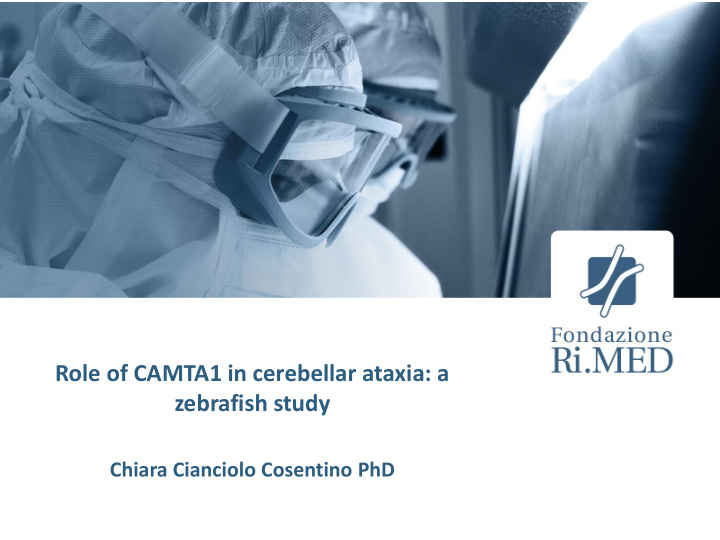



Role of CAMTA1 in cerebellar ataxia: a zebrafish study Chiara Cianciolo Cosentino PhD
CAMTA proteins: CAMTAs: calmodulin-binding transcription activators calmodulin binding protein protein domain specific DNA binding domain interactions • Evolutionary conserved transcription factors (from plants to humans) • Characteristic set of domains • In vertebrates: high expression in central nervous system In humans CAMTA1 mutations have been associated with autosomal-dominant cerebellar ataxia (Thevenon et al ., 2012)
Hereditary cerebellar ataxias Neurodegenerative disorders Motor incoordination, postural instability Cerebellar atrophy and Purkinje cells degeneration Genetic cause and pathophysiological mechanism for 40% of hereditary ataxias is still unclear No therapy available so far Long et al ., 2014
Aim of the Project: A further understanding of the normal physiological function of CAMTA1 and how his altered function leads to hereditary cerebellar ataxia will be important for the development of therapeutic strategies CAMTA1 KO Danio rerio Reflects the phenotype of CAMTA1 Fast development mutations in humans Genetic manipulations BUT: High degree of conservation of the nervous Detailed analyses of regulated genes in mice system between zebrafish and mammals is costly and slow to achieve Drug screening Aim of the project: Validate the zebrafish larvae as a model organism to study CAMTA1 dependent ataxia
Results: zebrafish CAMTA1 is strongly expressed in the nervous system Zebrafish CAMTA1 orthologue: camta1a • 73% AA- sequence similarity with the human protein • Expressed in the central nervous system larvae 5 dpf OT CE HB 500 µm camta1a adult brain section Granule cells Optic tectum Cerebellum Purkinje cells Hindbrain camta1a In situ Hybridization
Results: camta1a knock down experiments camta1a knock down: Morpholino antisense oligos control MO 1 mm 5 dpf camta1a MO Artificial oligonucleotides that block mRNA translation by binding to AUG 2 ng 5 dpf camta1a MO control MO E2 E3 E17 5’ UTR E1 MO Translation blocking 3 dpf Tg(huc:GCaMP5)
Results: Purkinje cells markers are reduced in camta1a MO control MO camta1a MO Purkinje cells D. Loffing In situ Hybridization Aldocl Aldocl Immunofluorescence Aldocl: aldolase c, fructose-biphosphate-like; Pvalb : parvalbumin 7
Results: ataxia phenotype in zebrafish Titolo slide Behavioral effects of camta1a MO: Movement pattern Aspatwar A. et al ., 2013; Mahmood F. et al., 2013
Results: camta1a morphants larvae have altered movement pattern control MO camta1a MO camta1aMO control Means of the distance swum in 5 minutes +/- SEM. P = 0.004 (unpaired t-test) • Abnormal swimming behavior at 5 dpf • Postural instability Aspatwar A. et al ., 2013; Mahmood F. et al., 2013
Summary and conclusion • Zebrafish camta1a displays a high similarity with the human protein • Mainly expressed in the central nervous system • Knock-down experiments showed a reduction in Purkinje cells, while the general morphology of the cerebellum remains unaltered • Knock-down of camta1a reproduced in zebrafish larvae symptoms of ataxia, with shorter swimming path and postural instability. Our results so far validate zebrafish as a valuable model organism for the study of CAMTA1-related ataxia
Generation of a zebrafish camta1a mutant line CRISPR/Cas9 genome editing • Analysis of adult phenotype will be possible • Less off-target effects than MO Reference sequence: GGAAAAAAAGGAAAGATGGGAAGACCACGCGGGAGGATCACA Mutations in F1 fish: GGAAAAAAAGGAAAGATGGGA-------------GGATCACA (-13 bp) GGAAAAAAAGGAAAGATGGGAAGAC---GCGGGAGGATCACA (-3 bp) TTTACAATAGAAAGAAG (-)x53GTGAAGGATCACA (-53 bp) GGAAAGA -----------CGCGGGAGGATCACA (-11 bp)
OUTLOOK: camta1a CRISPR/Cas9 mutant Purkinje cells sorting Microarray data analysis tagRFP-T:4xCa8:GCaMP5G characterization of the functional role of CAMTA1 in the cerebellum Development of potential therapeutic Candidate genes targets differentially expressed
Acknowledgements Neuhauss lab Loffing lab Prof Dr. Stephan Neuhauss Institute of Molecular Life Sciences Prof Dr. Johannes Loffing MD, Head of Division Institute of Anatomy
Summary and conclusion • Zebrafish ortholog camta1a displays a 73% overall similarity with the human protein • Like in humans and mice, expression analyses in zebrafish larvae showed brain- enriched camta1a expression • Knock-down experiments with camta1a antisense morpholino oligonucleotides reproduced in zebrafish larvae symptoms of ataxia, with shorter swimming path, and inhability to maintain upright posture • Like in CAMTA1 deficient mice, morphants larvae showed a reduction in Purkinje cells Our studies provides proof-of-principle that camta1a morphant zebrafish recapitulate salient features of ataxia and may represent ideal tools to address the pathogenic mechanisms underlying the disease phenotype in humans with CAMTA1 mutations
Results: kcnc3a expression is decreased in camta1a morphants control MO camta1a MO kcnc3a kcnc3a Kv3.3 voltage-gated potassium channel In situ Hybridization • Strongly expressed in Purkinje cells • Important for complex spike waveform of Purkinje cells • KCNC3 is mutated in spino-cerebellar ataxia type 13 Pascal Ender
Conclusion • We generated and validated a model of ataxia using zebrafish larvae • We showed that knockdown of the camta1 gene, responsible for ataxia in human patients, results in PC decrease and abnormal movement pattern in zebrafish, mimicking the ataxia phenotipe in humans and mice • Camta1a knock down zebrafish larvae can thus represent a good model system to address the role of CAMTA1 in HA • Generate a zebrafish CAMTA1 mutant line with Crispr/Cas9 tecnique Diverse CAM target Ca 2+ • proteins Find genes that might be transcriptionally regulated by camta1a CAM CAMTA1 CAMTA1 ?? Nucleus Target genes
Recommend
More recommend